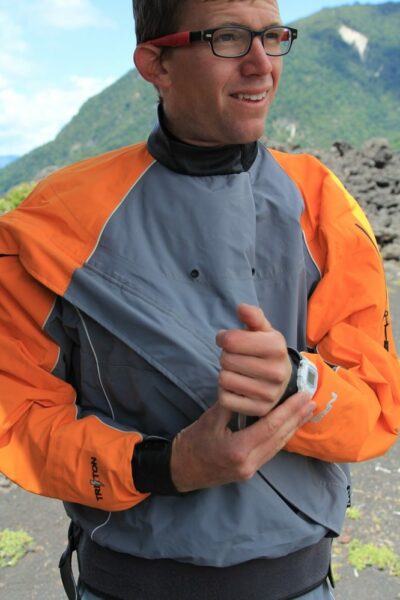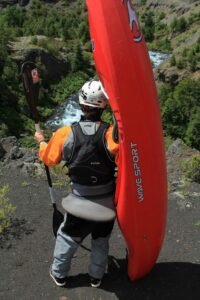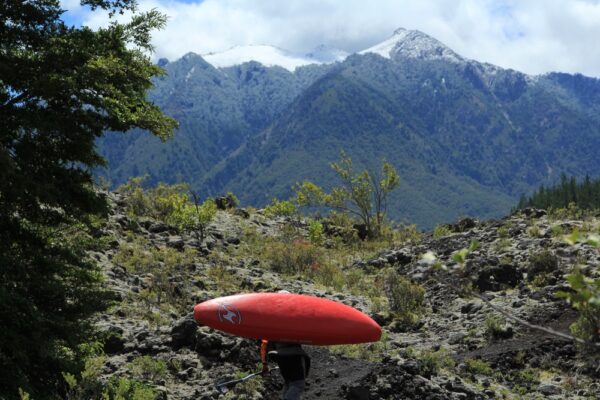Many of us can feel the quiet whisperings of fall creeping in: cooler mornings, evening breezes, and a little more rain. For seasoned paddlers, the shoulder seasons (fall and spring) and even winter mean some of the best whitewater boat riding around because our rivers and creeks tend to hold water a bit better. For newer boaters, though, it might mean falling into the misconception that it’s time to hang up your kayak and pack away your summer layers until next year.
We’ve got you covered.
Here’s a few quick reasons why paddling from fall through spring is worth it, even if it requires a little more preparation:
- It’s beautiful. Those tourists that drive around looking at the leaves changing, you know, ‘leafers?’ You, my friend, get the best view of all from the flow. Checking out fall colors, winter harshness, and the verge of growth in Spring allows you a view in to our changing seasons that even the most intrepid leafer won’t get.
- Rivers run. More experienced paddlers have that absolute favorite rain-fed river that usually only comes in after the leaves are gone and the watershed is primed for flow. The Class V gnar boaters chasing fall flows are on to something, sure, but there’s plenty of opportunity for newer paddlers exploring Class II-III to take advantage of more seldom run rivers due to favorable water tables.
- It’s quiet. Yes, yes, we love you, commercial traffic, for building up a community around a river and often ensuring us access and flow… but it’s really nice to paddle a less trafficked section of river sometimes, too, even if that’s our normal run without the extra populations of tubers or rafters.
- You’ll stay sharp. Ever taken a long time off from, say, running or biking only to get back into it and feel the groan and resistance of proverbial rust? Taking weeks or months off at a time can dull even the most expert paddler’s skills, but it can be especially challenging for new boaters that are amidst a crux of the paddling progression. Seat time matters, and taking a bunch of time off while fundamentals like rolling, strokes, or boat control are still developing can cause a frustrating set back when you go do dust off your gear come spring time; long gaps in paddling frequency can also be detrimental to your comfort on the water. Remember: mental is a muscle.
Have we convinced you that, perhaps, the juice is worth the squeeze? Maybe the extra layers and gear and a little bit of cold weather might still be worth it to get you out on the river? There’s a few considerations to make things a little less painful, we promise.
[row] [col width=”1/2″]

- Invest in the proper equipment. I know, I know, this is the part that no one wants to hear… spend more money on paddling gear! But, one of two things will happen if you don’t get the proper equipment: one, you’ll skimp and try to make something inadequate or inappropriate work for you, and you’ll wind up either putting yourself at risk as a result, or having an absolutely terrible time, at the very least; or two, all the rest of the gear you just invested in will sit, unused and unloved, in the corner of your garage until it’s warm enough for you to use it again. Either way, you’ll wind up feeling like you’ve wasted your time or money, or both.
- Base layers: Capilene or merino wool, fleece… just, no cotton, please. These layers are meant to insulate, so they work best when dry; read: under dry wear. Neoprene isn’t a bad compromise- I’ve used it as a mid-layer in moments of desperation, but remember that neoprene’s insulating qualities are magnified when it’s wet, not dry.
- Dry wear: You need a dry top. Even investing in just a dry top can keep you paddling for an extra month or two on either end of the summer season if you’ve got your bottom-half layering system worked out. My favorite combination is a dry top with synthetic layers underneath, and neoprene bottoms; I’m warm and dry on the upper half and adequately preparing for getting a little wet on the lower half.
That said, my personal opinion is that a drysuit is worth the extra coin as opposed to the dry top / dry pants combo, especially if you’re looking to really get your money’s worth in winter months. A combo of dry top and dry pants is nice, but it has a fail point… and, trust me, you don’t want to find it after an out of boat experience in freezing weather.
- If you can, save up and get a good drysuit as opposed to trying to economize.That said, if you’re really in a pinch, the dry top / dry pants combination is better than nothing at all. I find myself in my drysuit later and later into the summer, accommodating for warmer air temps with lighter layers underneath. You can sometimes find good deals on older models or even lightly used drysuits, but I promise, it’s worth the investment if you’re wanting to stay in your boat year round. Nothing is warmer or safer than a good dry suit, and it’s definitely a game changer in managing inclement weather while still getting to go boating.
- Additional accessories: For when it’s really, really cold, many paddlers opt for gloves, mitts, or pogies to protect their hands on really frigid days. I personally prefer pogies, which wrap over the paddle itself, as I like to still feel contact with my paddle, unimpeded by gloves or mitts. Try a few different options by borrowing from friends, if you can. My absolute favorite cold weather accessory is the NRS Storm Hood, which goes over my head entirely and tucks inside my drysuit. Skull caps are a great alternative; head protection made from a synthetic material like fleece or neoprene- heck, a beanie at the very least- can go a long way in keeping you comfy when you tump over on a cold day.[/col] [col width=”1/2″]
- Take a rescue class. This is kind of a no brainer… but let me just say, quick and effective rescue gets even more important when temperatures start to drop. Prevention is paramount. Getting swimmers out of the river quickly is critical. Enroll in a rescue class at the end of the summer so that your mind is sharp and your skills are fresh and ready for application in an environment that will demand good judgement and precise execution. And, carry a good set of gloves with you in your dry bag in case you need to work rope systems in cold water. We are hosting an Advanced Swiftwater Rescue Course this winter is you want to see exactly what we are talking about!
- Adjust your judgement. Speaking of judgement, risk assessment should shift a bit when you start paddling year-round. Many paddlers will agree that the time to really push yourself probably won’t go hand in hand with freezing temperatures. To each her own, but think hard about potential outcomes for stepping up to a new river, rapid, or line when the weather changes. Hypothermia is real, both for you and your potential rescuers. That’s not to say that you can’t or shouldn’t paddle new runs (I mean, why am I writing this article, after all, if that’s not the case?) or even accept some new paddling challenges, but weigh your environmental hazards perhaps a bit more heavily than you normally would when assessing the time and place to step it up.
- Plan for your environment. If you’re not carrying a first aid kit, you should be, and your winter kit should have hand warmers and a space blanket; I even have a few paddling buddies who will bring a small Jet Boil or a Thermos of hot water for potentially long, cold days. Pack down layers in a dry bag, lots of warm clothes and blankets in your vehicle, and get to know access points around your river in case of unforeseen challenges. Eat well and drink lots of water… that doesn’t change much from summer, but it’s easy to forget that nutrition and hydration is important when it’s cold, too. Further, part of planning for your environment means acclimating to it, so don’t wait until the middle of the toughest rapid during an unexpected roll to get used to how the cold water feels on your head or what your new pogies do to your rolling comfort. Put in and flip over. You’ll thank me later.
- Go to the pool. Or lake, pond, flat river, etc. Seek out opportunities to keep rolling, flipping, and paddling, even if it’s not on your normal stretch of whitewater. If you don’t use it, you probably won’t lose it… but it definitely won’t feel nearly as comfortable or familiar to you as it does when you’re getting some frequency.
- Hydrate and fuel properly, and well in advance. Focusing on hydration and nutrition in advance of cold-weather energy expenditures (read: kayaking) is one of the best things you can do for yourself to keep your motor skills sharp and prevent hypothermia. Colder temps can mask the body’s natural cues for hydration, and you may miss miss the opportunity to hydrate as needed as a result of your body not sending you thirst signals, making dehydration a real possibility- and problem- on colder days. Make sure you’re giving your body adequate fuel before, during, and after winter paddling to help your system continue to effectively generate heat. You need calories as fuel for the fire! Pack snacks and water along with you for your day on the water, but don’t forget that prevention is the best medicine and start nourishing and hydrating the day before.
- Don’t stay home. If you’ve followed the above advice and gotten good gear, practiced using it, and are using otherwise good judgement, there’s no reason why you need to stay home when the weather turns sour. Remember some of those long-lost, favorite-day-ever memories from when you were a kid? Some of them probably involve splashing around in a mud puddle in torrential rain for hours on end, or having to literally get dragged back inside before midnight after playing in the snow with your friends since dawn. Kayaking is no different; there’s no reason why weather should dictate the amount of fun we have or whether we have any fun at all… in fact, sometimes rainy or snowy days are the beginnings of some of our favorite days on the river. Take heed, keep a good head, and go kayaking.
For some additional information on the science of cold-water exposure, check out this article on the dangers of cold-shock. Cold water immersion in the winter time is dangerous without the preparations above.



Found myself staring at it for minutes.beautiful words, totally agree that fall to spring is a great time for paddling, with those pretty wind,and crystal clear water, it feels better than summer,totally missed about taking rescue lessons by myself,hope I take it in future,it will be good for me and my group, if they need it sometimes.
Diet!! Lots of fats & fiber. It starts on the inside.
Good point! Lots of folks forget about how nutrition and hydration affect our comfort and longevity in the cold. Thanks for the reminder!